
Abueva Works & Words
By: N. Veloso Abueva
Concept of Design
Whatever desire
is expressed in Form,
one conceives
in the realm of Design
the mind in
the hand can falter
or surpass!
If you answer which one
how much was done by love?
Executed into sculpture in bronze.
Collection of Mrs. I.R Marcos
(originally written for the 3rd one-man design show, Architectural Center, Makati, 1960)
On Being A SCULPTURE
A sculpture is like a price fighter and a matador all rolled into one. As a boxer, he has to be on the top condition, mentally and physically. The latter demands a sustaining courage and grace to remain in the arena.
When I was very young, the materials of sculpture were so yielding and responsive. Now that I am older, I have come to terms with the stubbornness and coldness of these materials. They are making me aware of the years that I have gained.
I work on functional objects on the basis of sculptural problems, rather than on utilitarian objective, as diversion from pure sculpture. --
--1969
CONTEMPORARY SCUPLTURE IN THE PHILIPPINES
BEFORE THE LAST PACIFIC WAR, practitioners in sculpture were primarily on the traditional methods such as modelling in clay and direct carving in wood. A great majority of the modeled clay would normally undergo the molding and casting process and become a plaster or concrete cast and a few would eventually cast in bronze in Italy.
Among the sculptors who did the clay to cast method were Professor Guillermo Tolentino, Francisco Monti, Anastacio Caedo, and a few others. All of them work in a classical or conservative manner with the exception of Francisco Monti whose works were stylished and more conventional.
In direct carving in molave wood, Sculptor Graciano Nepomuceno stood almost alone. His depiction of familiar themes in high relief and religious pieces were exquisitely carved. In direct carving in marble or stone it was rather rare except for the number of pieces executed by Tolentino and those religious piecesdone by a tallieres or studious of Maximo Vicente and Oriol. Practically all marble used in statuary came from Italy. The churches and cemeteries were the usual consumers of these statues and hardly any of them would find its way into the private houses. Romblon marbles was never used seriously as a sculptural material except in recent times.
Some years after liberation, Ramon Estela did some direct carving in adobe. The few pieces he carved possessed the quality of some primitive stone sculptures in the Indian Aztec. The immediate years following saw the application and the experimentations of new methods, techniques and materials in which the emerging generations of sculptors preoccupied themselves. Their concept in art, their outlook in life was no longer identical with their former mentors but in most cases they were at variance. Consequently, the redefinition and re-evaluation of what is considered “ a thing of beauty” in sculpture and in art in general underwent a drastic and dynamic transformation. This change in concept was attuned to the changing sensibilities of the times.
Form in itself assumed a new plastic dimension and significance. Contemporary sculptors became mainly obsessed in creating forms which they considered significant. The literal meaning of the forms they made were nowhere to be found and they deemed it unnecessary in most cases. Gone were the usual sweet depiction of the beautiful or lyrical countryside, which were the favorite concern of the older group of sculptures and painters.
And in the process, as the contemporary sculptors became so immersed in their pursuit to produce forms per se, the further they became alienated in presenting themes which were typical or native, least to those who subscribe to the old and fading sensibility. Pure form and good design became the paramount objective. Unconsciously, their works did not bore the character nor can it be equated to a particular body of works.
With the rising nationalism in the fifties and sixties, the question or issue was discussed and talk about. To some perhaps in their desire to attempt to contribute to the issue at hand, some artist tried to depict Philippines motifs in their works. Unfortunately, nothing significant resulted in their attempt, for they realize later that it was a superficial imposition on their part and not voluntary and natural impulse to do that particular body of works.
It must be taken into account that for so long the orientation of the most of our artist has been in western thought or school. To expect them to produce suddenly a body of work which would reverberate the national idiom or identity, to the satisfaction and whims of our outspoken nationalist, is not impossible but utterly deplorable. “Art is long and element of time cannot be disregarded.
National identity in art is desirable but not necessary. The immediate and foremost duty of the Filipino artist is to produce good art, as it is the duty of any artist elsewhere in the temporal world. The elements of arts are universal and impersonal in nature and these elements give essence and validity to the so called international style or school. As a sculptor, I have always believe that whatever desire is expressed in form, one conceives entirely in the realm of design and no other consideration should be seriously taken into account.
These days our sculptors are engaged in practically all contemporary techniques in sculpturing. They do not only cast their works in reinforced concrete but also in bronze using either the sand or the loose wax method. Among the sculptors who cast their works in their improvised but efficient studio foundries are Francisco Cruz, Jose Mendoza, Abdul Mari Imao, Leonides Valdes, and Napoleon Abueva .
Those who normally do direct welding in acetylene or electric welding are Gewrry and Virginia Navarro, Eduardo Castrilo, Solomon Saprid and Abdul Mari Imao.
Those who work on combination of welding, constructing and metal rising are Lamberto Hechanova, Raul Isidro, Mercado, Beltran, and others. Materials such as sheet metal in brass, copper, aluminum, lead, and plastics are now commonly used. Some are already experimenting in resin and glass.
The practitioners of the traditional methods of molding and direct carving but in contemporary style or manner are Jose P. Alcantara and his son, Boy Caedo, Froilan T. MAdrinan, Jr., Victor Tabernilla, Rene Rocha, Ross Arcilla, IIdelfonso Marcelo, Romulo de Jesus, Anselmo Dayag, Eugenio Bunuan, Jose Flores, and others. Roberto Chabet and Ray Albano’s group are engaged in environmental sculpture and some related experiments which possess some degree of sophistication.
Arturo Luz works on wood and metal with plastic architectonic forms. Danilo Dalena works on Plastic and comes out with striking sense of plasticity. While it appears in this paper that there are quite a number of sculptors, the facts remains that there are really a handful of full time practicing sculptors. It is rather a paradoxical that with so much to be done in private homes and commercial edifices, there are so few sculptors who are really actively working. Likewise, in schools, there are hardly any students majoring in sculpture. Why? What does it really take to be a practicing contemporary sculptor?
The truth of the, matter is that aside from manual labor involved in practically all its aspects, a sculptor has to be a carpenter, mason, welder, plumber and at times electricin and above all a sort of weight lifter. On top of this, the highly expensive tools and materials in sculpture make sculptureing prohibitive, especially to young sculptors. With all these requirements, it certainly does not encourage students to be sculptors’ inspite of the need and increasing opportunities.
Much as I would like to see more art students take up sculpturing, I do not, as a personal policy, freely encourage them to be prospective sculptors, being so mindful of the demands of the profession. Only those who have made up their minds and have been fully exposed to the various types of work involed are to be encouraged and given all possible assistance. --1970

THE FULBRIGHT PROGRAM’S CONTRIBUTION TO PHILIPPINE DEVELOPMENT IN THE VISUAL ARTS
EARLY THIS YEAR, when Dr. Ruby K. Mangahas, is a very active director of the Philippine-Fulbright Scholars Association, informed me of my participation in the 30th anniversary of the Fulbright Program in the Philippines, I was originally assigned to speak or report on the visual arts, being a participant in the field.
The assignment could not have been too difficult since all these years I have been struggling in my chosen field of livelihood. The many and now distinguished beneficiaries of the program have been my contemporaries, especially the younger ones. Furthermore, we are all familiar with their works and the respective contributions to the arts. However, when one has to speak of the contribution of the arts to Philippine Development, that is a complete different story and frankly, I feel like a stranger in my assigned field. For some time, the assignment seemed insurmountable, engulfing my mind and heart. Later, it reminded me an experience twenty four years ago when I had to fill up the Fulbright application form in which one had to stat one’s objective, what one intended to do upon one’s return and so on and so forth. I must have sounded like a missionary then, like other applicants. This time I’m afraid, I might sound again like a missionary. But perhaps with the difference with that, to some extent and with the sense of satisfaction, I have done some of the items I stated in my application form.
My problem now or dilemma has been compounded by my own suggestion to Dr. Mangahas that architecture, interior design or industrial design, photography and theatre design be so represented, since the program includes these fields, with some outstanding grantees.
To minimize my problem I thought of a way of helping myself out. In covering the field of interior design, I gladly sought the assistance of our good friend, and a pretty good person and practitioner, Ms. Edith L. Oliveros (FSM ‘60). So, an informative and good page has been added to my short.
Similarly, in Architecture, I did not hesitate to solicit the assistance of architect Leandro V. Locsin (Specialist '59). Mr. Locsin’s statements and also those of Mr. Nicholas Polites on the architecture of Mr. Locsin have also been incorporated in the paper. With said addition and some quotations from other sources, I think that my modest participation in this evening affair will be fair enough. If not, please add a few more points from the small exhibit at the lobby plus your power of positive thinking.
We live in the age of great challenges, excitement and adventures with man trying to respond as well to the human and physical problems of his time. As part of this response, we have witnessed the marriage of art and industry, art and technology, art and and science. Some may say the union illicit or lecit but the fact remains that it is a contemporary reality. In the Philippines, It is no longer surprising to find artist actively involved in theatre and industrial or trade design, in photography and film, advertising and typography, science and industry, whether in government or private business. In Brief, artists have become more and more involved in the day to day life of their community.
“Speaking of how Philippine architecture relates to society, Leandro V. Locsin once observed:” The architecture of my country is a syntheses of our society. Our art of building reflects our people at a specific time, their aspirations, traditions, culture, economic resources, technology, environment, climate, and all the other components of Philippine society. This relationship between architecture and society is universal, for it exists in other cultures beside ours. Yet the relationship has another dimension, in as much as an architect’s work is the expression of one individual, the person who puts himself into the particular problem that a structure addresses, whether it is a house, a building or any structure designed for particular function. In this sense, it is the architect’s subjective view of a specific challenge to which he responds with a personal solution and personal statement.”
Mr. Nicholas Polites, who wrote the introduction of the book,: The Architecture of Leandro V. Locsin,” in turn has observed (about the art of Locsin) and I quote:” He (Locsin) is by far the leading architect in his country. Already he has put an indelible stamp on Philippine architecture through his work spans only a little twenty years...
“The most ambitious attempt to merge art and architecture is seen in the Cultural Center’s Theater of Performing Arts, commissioned by the new First Lady, Mrs. Imelda Romualdez Marcos in 1966. Giving a free hand In the design of the building its interiors and its embellishment, Locsin deliberately reserved carefully selected wall areas with the work of specific artist in mind, such as the Manansala brass sculpture in the orchestra foyer, the Castrillo stainless steel sculpture, and the spectacular murals by Legaspi and Luz in the small theater. Instead of the usual brocade or velvet curtains, he had tapestry woven after a painting of Ocampo for the large theater, defining the color range of both to contrast and to relate with the interior surfaces. The resulting theater, remarkable structure, is now an internationally recognized Manila landmark.”
Mr. Polites further observes:
“The idea of architecture plays an important role in many of Locsins’s later building s, The lobby of the Theater of Performing Arts, for instances is another hollowed out sculpture, - here stairways rise out of the floor in the flowing lines or seem to uncurl in symmetrical rings when seen from below. The monumental clocks of the International Convention Center are meticulously formed to lighten the massing and their arrangement is pure and simple sculpture on a gigantic scale. The interiors are extensively sculpted the grand sweeping stairways, which appear to emerge organically from the floor: the molded concrete balconies mezzanines their profiles softened and contoured to contrast with severe linear elements. But the idea of sculptural interior is by no means arbitrary,” “I have already thought that what happened inside a building should release to the outside”, says Locsin. The sculpted quality of the lobby merely continues the sculptural concept of the exterior.
All the new buildings for culture and the arts spring from the common root, however different they are in outward appearance and function. They were planned to foster national pride in the Philippine heritage. The arts, in the Marcos administration’s view, are profoundly involved with the spiritual welfare, the soul of the nation. Both the creative arts and the performing arts are therefore actively encourage by government policy to help developed in the Filipinos a sense of national consciousness too long dormant under centuries of foreign domination.
“The edifices commissioned for social, civic and scientific projects with which the First Lady is equally concerned also reveal the unmistakable feature of Locsin’s synthesis of what is Filipino. The Population Center of the Philippines, the Nutrition Center, the Asian Center of Training and Research for Social Welfare and Development, and other related edifices are characterized by vernacular building features.”
Finally, Mr. Polites observes: On every level, Locsin is profoundly involved with Philippine, culture and this could be termed as Philippine architect.”
In the field of Interior Design, we have a very active and leading practitioner who has been and still as the Director of the Cancio School of Interior Design, Fullbright-Smith_mundt grantee’ 60 from Drexel University.
Miss Oliveros has this to say: “The past twenty years have been an active period in interior design in the Philippines considering the development of building both residential and commercial structures that has taken place in all areas of the country. With the development of architecture come the awareness of the interior design, hence the rapid pace of the profession and the allied trades.
“Today, we have an active profession ranging from the purely professional interior design to the more informal decorators, drapery makers, and furniture manufacturers, artist and artisan, to the interested general public who has become aware and cognizant of the contribution of the interior design in our quality of life.
“The contribution does not only lie in the creation of beautiful rooms but also in the development of functional interiors, most especially at the time when life for many in the urban areas have become more complex. We have introduced into our lives a necessity for mechanical equipment’s such as air conditioning, sound systems, noise control, special lighting systems, and more efficient storage and spaces for physical, intellectual and spiritual development. The need for just basic shelter no longer holds true and today in the Philippines homes we find the answer to the need for a home, for an environment that services our lifestyles be it simple apartment or a bigger residence for an executive a building for a businessman or a mansion for the affluent.
“It is an exciting time for interior design in the country for the development is now reaching the greater number of the populace. Coupled with the inherent interest of the Filipino for beautiful things, more allied traders such as woodworking, furniture making carpet and wallpaper manufacturing are developing their products. It is also the time for the development of a lot of native materials that can be used for homes and the average Filipino has finally accepted that what is local is good and can be used beautifully.
“One can go leisurely into our commercial buildings our shopping centers, small housing villages, small stores and apartments, big hotels, beauty parlors, our major cities and smallest towns and one cannot but see the influence of an interior designer. The directions at least are there.”
The degree of community involvement, activity and interest among the local artistic community during the past ten years was also made possible by other Fulbrighters in the field of architecture, photography, painting and sculpture. Among them is Architect Honorato Paloma who is presently involved in town planning, ecology and education, is also the architect in charge of the U.P. complex in Miagao, Iloilo and soon to raise U.P. Film Center in Diliman, Architect Jaime Nierras who is in government construction projects; architect Angel E. Nakpil and Jesus Bondoc who are both actively engaged in private practice; theater designer Salvador Bernal who is presently very active in stage presentation in the country; photographer Evaristo Nievera who branched out into film documentary; painter Constancio Bernardo who is very active both as artist and educator ; sculptor Abdulmari Lmao, who is currently immersed in scholarly research and dissemination of indigenous and traditional Muslim art and design the adobe sculptures of Ildefonso Marcelo grace the grounds at the U.P. in Quezon City. Painter Rodolfo Paras Perez, the first Filipino artist to get doctorate in art history at Harvard, is now actively engaged in the print media aside from his art, research and teaching; paiter Arturo Luz who currently heads the MOPA, the Metropolitan Museum of Manila and the Design Center of the Philippines which provides the guidance to local trade and industry for their graphic need and requirements; painter Jose Joya who has done murals to the private and public buildings and theater productions design is also in ceramics; painter Federico Alcuaz who is also a ceramics and now sculptor, has done a lot of tapestry for private and public buildings and will do the tapestry murals for the new Olympic sports palace in Moscow; and recently Ray Albano, curator of the CCP who undertook a unique art experience in disseminating Philippine visual activity in states grantee who has for many years now been in furniture design and also in amusement parks for children as well as sculpture for public and private use.
With the increased tempo of artistic and creative activity in the various fields of human activity, public appreciation and recognition for accomplishments of our artist have also increased. There are more art collector’s art galleries and art dealers now.
One cannot help but mention the valuable contribution of the first lady, Mrs. Imelda Romualdez Marcos. To mention only one of the many art in society.” This has limited the inventiveness of most artists to purely stylistic experiments or the indulgence in fantasy or the depiction of the grim humor or nostalgic recreation of past eras.
The question of “whom art should serve” becomes the most pressing question for the artist who seeks to makes the artist of “whom art should serve” becomes a most pressing question for the artist who seeks to make his art meaningful and responsible not only to himself but also to his people. (On this score, I must admit that I am one of those wanting in this particular aspect though conscious of this shortcoming). He must realize, for the sake of his art and his people, “That although art is universal, its universality is particularized by geographical, racial, social and historical condition and development of individual societies. Indeed, it is through the artist’s creativity that the individuality and peculiarities of man and the human condition in the artist race, moment and milieu are transmuted into art and the specific and the particular are crystalized and elevated to the ideal and universal.”
In our nation’s Constitution, it is stated that the promotion and enhancement of art and culture must be the prime concern of the state. However, if the implementation of this constitutional provision, it is to suit the vested interest of few, then the state might as well disregarded this provision.
We should not be merely preoccupied with our bare existence with rice and fish to the exclusion and at the expense of the appreciation of the finer things in life that lend beauty and meaning to our lives. --1975

THE STATE OF THE VISUAL ARTS
Much has been said and written about the state of the visual arts at present, the very active and successful artists and the ever-widening base of art clientele or patrons in the Metro Manila area and a few isolated cities outside Metro Manila.
These artists, consciously or unwittingly, serve the interest, predisposition or inclinations of their patrons. Just as it has been observed, that art or culture of a given period in history serves the interest of a select or prevailing minority. This apparent allegiance to the controlling class is its comfortable and uncritical submission to the prevailing order of things education varies in the degree of importance and emphasis according to the deeds of the individual whether he intends to be practicing artist, an art appreciator or merely desirous to be enlightened in the multiple aspect of art education.
Art schools and colleges at most could only provide an impart the rudiment techniques and skills imperative in the visual arts.
The curriculum which provides general education courses in the first two years out of a four year curriculum is practically standard feature of most arts schools. An indeed two shorts year of subjects in the humanities is sadly wanting and so glaringly inadequate. At most it is a sprinklings or what you may describe in Filipino as “padapyas dapyas lng.” Why is it so or why it has to be this way is a question of element of time. There are indeed a number of subjects to contend with the field of specialization in visual arts, such as sculpture, painting, and visual communication and in art education proper.
Thus it is to the advantage of students who supplement this inadequacy by exposing themselves to the various offerings presented in the other arts throughout the academic year, namely the performing arts and the theater arts. This is where a student in the university or big institution has the added advantage if they avail themselves of the many undertakings presented by the other art disciplines.
The constant exposure, association and broadening of the artist to other related arts is of paramount importance. However, the fact is that most graduates in the fine arts are wholly preoccupied in their field of specialization and hardly knowledgeable of the fundamentals in the other fields of tradition seven arts.
In last Saturday’s discussion, the barcada system or grouping of artists was mentioned by Mrs. Pura Kalaw Ledesma. While it has some good points in its association and fellowship and in achieving desirable goals, in most cases it does provide little room for advancement in broadening their respective perspective from within. Just like the saying, that birds of the same feathers flocks together. And unless a bright and new bird develops or is introduced in the flock, there would hardly be a change in their direction and improvement.
At this juncture it might be of interest to ask a hypothetical question regarding the possible effects on the part of our late National Artist Botong Francisco, had he been able to travel. It is common knowledge that for so many years Mr. Alejandro Roces, before and he was a Secretary of Education, several times tried and secured scholarship for Francisco to travel and observe art trends and centers abroad. However, Botong Francisco always came up with the same problem. Or excuse that he was not in a position to leave until death overtook him. Of course, it is debatable whether an exposure, say to Mexican art in general and mural painting in particular would have a positive or negative effect in his art. Certainly, this does not imply that he could have been greater as a result of more exposure and broadening of his pictorial and intellectual horizon.
Our contemporary artists by and large have been successful in producing quality works of art. In Asia, it is safe to say we are ahead compared to other countries in the region as far as depiction or interpretation in the contemporary idioms. Nevertheless, no matter how good the composition, color,” the swirl of impasto,” and form, there is the question of intellectual content, the elusive quality of element which tends to elude even some of the best of our works. This question of depth always persists in the evaluation of major art works.
At this point, I am afraid I am going to lose some of my friends for being critical and frank. However I must tell you, I am not an exception to this charge or indictment if you may consider it as such. Perhaps at this very instance, an art critic ought to be saying this thing. He would be less vulnerable than a practicing artist. But we have to admit the fact that if we would be doing a disservice to the real development and promotion of our art. Indeed it is difficult to pinpoint or zero in such element because of its unapparent nature but somehow seemingly apparent of its absence when confronted with a given work of art.
There are no ready explanations on this matter. At most, we can only cite and deduce from the training or education of a particular great master of the past and of all times.
In the world of Giorgio Vasari, a contemporary and a friend of Michaelangelo, “but he who bears the palm of all, whether the living or the dead, he who transcends every other, is the diving Michaelangelo Bounarote, who takes the first place, not in one of this arts only, but in all three (obviously this refers to sculpture, painting, and architecture). This master surpasses and excels not only all those artist who have well high surpasses nature but even all the most masters of antiquity who did, beyond all doubt vanquished her most gloriously, he alone has triumphed over the latter, as over the earlier, and even nature herself.”
It must be recalled that when Michaelangelo was summoned to the court of Lorenzo de Medici, at a very young age, ‘he was virtually in the community of scholars. For in those years, the Medici court was composed of the most famous poets, philosophers and artist of the time.
One can deduce further the fact that in later year that the most favorable environment in intellectual pursuit, he must have imbibed and benefited from his exposure and association with the profound thinkers of the time.
The innate genius that he was must have been fortified from these rare and most favorable if circumstances. The range of Michaelangelo’s subjects is too vast to contemplate in which a mere plastic and pictorial training and experience would be insufficient.
The conceptual diversity and scale of his immense works must have been gleaned from and influenced by the thinkers and the scholars in the Medici Palace. Truly, his case is a classic example of the importance of the humanities in the life and work of an artist.
In the early decades of the century, the great French sculpture Auguste Rodin, was always in close association with the leading thinkers and writers of his time and the great artist in their fields especially the dance.
Likewise, in more recent times Norway’s Gustav Vigeland, the sculptor responsible for the famous sculpture in Oslo has among his associates men in Literature and Art Criticism.
In speaking of the advantages and profound aspects that humanities play in shaping and remolding the intellect of an artist, I cannot help but cite the unique case of our own, Hernando R. Ocampo. A writer in Filipino and in English, he was once an editor, art critic, producer of radio plays and a member of progressive movement. Simply, Mr. Ocampo has been an active participant in the mainstream of literary and visual activities for so long. Mr. Ocampo, positively, has sizable advantage over, most of us and he is one of our foremost artists in the Philippines today.
Paradoxically, as far as the records of leading art schools in the country are concerned, H. R. Ocampo does not exist.

UP Gateway. 1967. Reinforced Concrete Diliman, Q.C.
Associate Designer: Architect Jess Reyes
Builder: UP Physical Plant

Consummate Embrace. 1970. Bronze. Artist's Collection

Caganapan. 1957. Marble. Artist's Collection
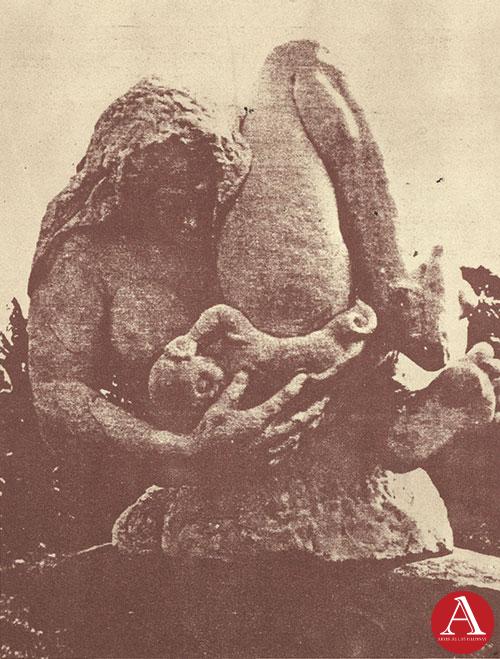
Bagong Buhay. 1974. Marble. Artist's Collection

Baby Moses Floating. Sculpture. 1951. Wood. Cranbrook Academy of Art, Michigan, USA
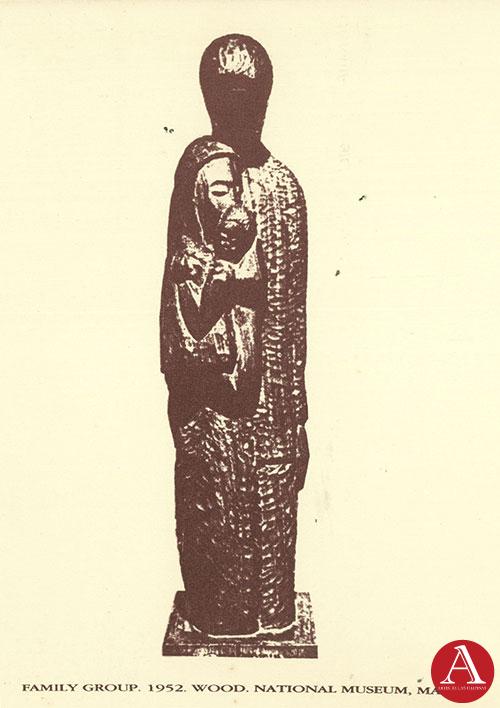
Family Group. 1952. Wood. National Museum of the Philippines

The Rice Planters. 1952. Wood. Purita Kalaw-Ledesma Collection, Makati
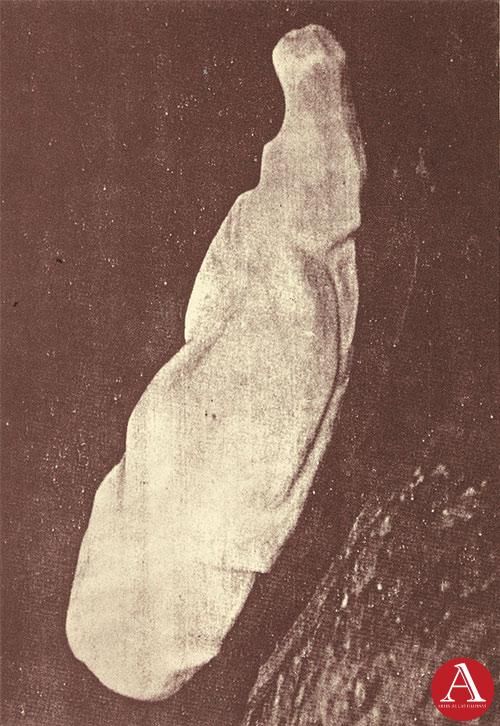
(Water Buffalo). 1968. Marble. City Art Museum, St. Louis, Missouri, USA
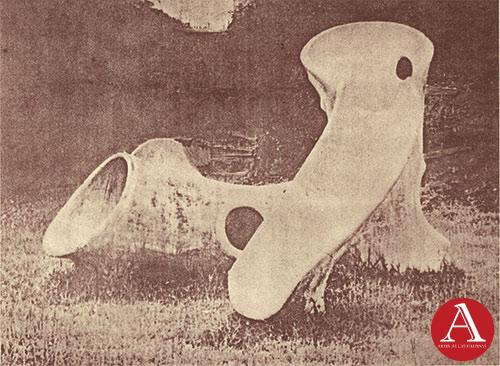
Play Sculpture. 1968. Reinforced Concrete. Artist's Collection

Divider and Reception Desk. 1967. Wood and Metal. Meralco Building, Manila

Door J. Moreno Residence. 1966. Bronze and Wood

Sculptured Bench. 1977. Wood. Artist's Collection

Woman's World. 1971. Marble. Private Collection. USA

Born Free. 1967. Wood and Iron. Camp Aguinaldo

Water Catapult (For the Burning of Books of Alexandria). 1990. Wood, Broze and Copper. Artist's Collection

Homage to D.M. Consunji. 1973. Reinforced Concrete. Cainta, Rizal

President Carlos P. Garcia Statue. 1962. Bronze. Tagbilaran, Bohol
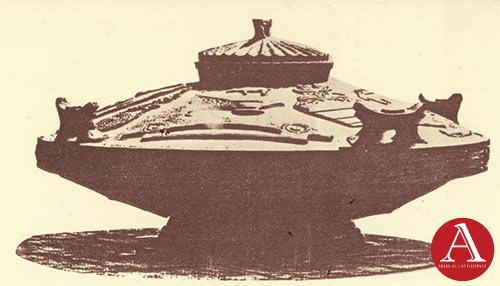
Ceremonial Urn at Dambana ng Cagitingan. 1968. Reinforced Concrete
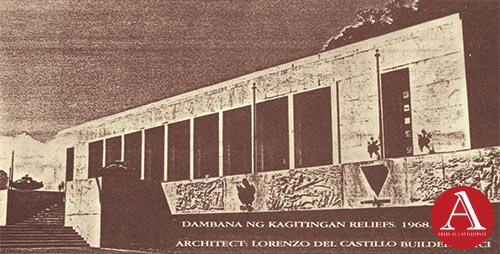
Dambana ng Kagitingan Reliefs. 1968. Marble. Architect: Lorenzo del Castillo DMCI-Builder

High Reliefs at Dambana ng Kagitingan Cross. 1968. Reinforced Concrete. Mt. Samat, Bataan

Structure. 1969. Wood and Iron. UN Building, New York, USA

Tribute to the Filipino Entrepreneur. 1970. UP Institute of Small Scale Industries, Diliman, Quezon City

Ilohan (Presser). 1970. Wood. Stone and Bronze. Development Arts of the Philippines, Tagaytay, City

Allegorical Harpoon. 1964. Wood. XXXII Venice Biennial. Cultural Center of the Philippines
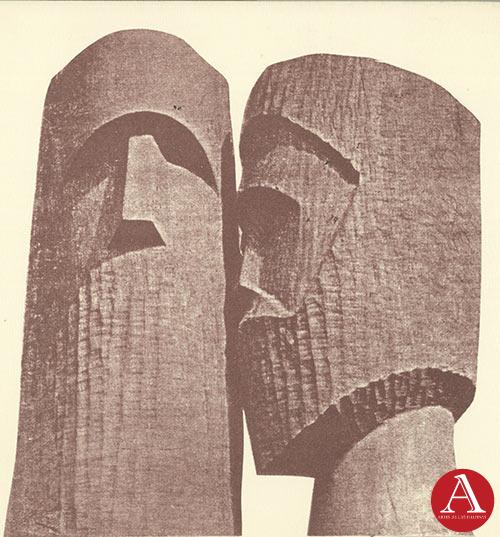
Kiss of Judas. 1955. Wood. Detroit, Michigan, USA

Crucifix. 1957. Wood. U.P.Chapel, Diliman, Quezon City. Leandro Locsion Achitect DMCI Builder

Moses. 1952. Alabaster. Galerie Bleue, Makati
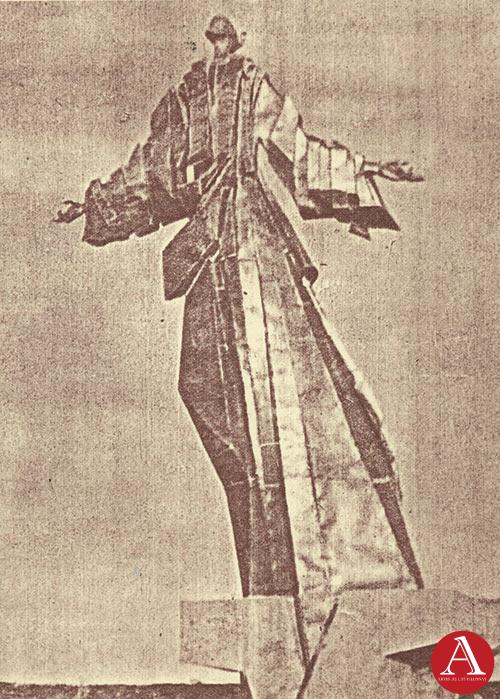
Transfiguration. 1979. Welded Brass. Eternal Gardens Memorial Park. Caloocan City
CITATION
Napoleon Veloso Abueba, hardly in his middle age, is the acknowledge patriarch of modern sculpture in the Philippines.
Restless, daring, imaginative he blazed new paths in his chosen art. A protean innovator in a craft which demand high skill, he is the weather vane of contemporary sculpture, planting the seeds of future growth in creation whose full implication, in terms of form and their limits in terms of material, remain the object of continued exploration by his peers and apostles.
Napoleon Veloso Abueba is the born expirementor . Seeking to extend the boundaries of his art he invented “buoyant sculpture” which has intrigued puzzled and finally inspired his generation of sculptors. He has also created play sculpture and sculpture furniture, both of which reflect his originality and versatility.
But it is for his large monumental works for which he is best known. In the figures of the Christ that he has hewn for chapels and churches all over the country, he reveals an unsuspected religious spirit, large in inception, large still in inspiration. The same spirit informs his secular works as in the historico- heroic murals commemorating the virtues of the race in numerous national shrines.
Napoleon Veloso Abueva is an artist of unquestioned power and seriousness. Massive abstraction of incredible variety and diversity an unfailing inventiveness, a prodigious energy and inexhaustible inspiration firmly imprint his signature in the art of our time. His works are a metaphor for his world and his age.
In these achievements, the country takes his pride.
CITATION OF THE NATIONAL ARTIST AWARDCONFERRES ON NAPOLEON VELOSO ABUEVA BY THE PHILIPPINE GOVERNMENT ON MARCH 27,1976

National Artist Medallion and Collar

The Abuevas. Left to Right. (Seated). Purificacion, Sergia, Socorro (Jose's wife), Amelia
(Standing) Anthony, Napoleon, Teresita, Teddy and Jose

Bridge of Love. 1970. Reinforced Concrete. Artist's Collection
PROLOGUE TO THE MOBILE ART AWARDS AND THE SEARCH FOR THE MISSING LINK
It is a fact that most of the paintings are visually beautiful in terms of color, composition, design, subject matter, or even the concept. Most of our paintings are simply a feast for the eyes. But must this kind of picnic (for the eyes) be at the expense or exclusion of the intellectual content or ethical message?
So my immediate reaction upon reading about the 1980 Mobil Awards for Philippine Art was that of admiration and gratefulness to Monsieur Jean Pierre Baileux, Mobil’s president, and the sponsor’s continuing involvement in the advancement of ”the cultural life of the country.”
The establishment of these biennial awards provides a rare and ideal venue to underscore or emphasize the importance of the missing link in our visual arts.
What I mean by the missing link or the plus factor can actually be created if the artist has concern for meaning in depth, or the so called intellectual content.
It is difficult to decipher it sometimes. Yet this quality is always apparent when present in work of art.
Let me cite the examples of Edward Munch and Paul Klee’s paintings, the work of the former possess a sober intellectual content while the latter has witty and sometimes sober was always profound cerebral content. These two artists of course grew up and developed in the western world which is highly intellectual. But is it too much to expect the same qualities two artist have from our own artist. As a people, we are said to be the happy go lucky type. Life in our corner of the globe is not as hard as compared to that in temperature countries. Our sun is always up and our climate is said to be influenced our way of life. Life here is not too serious, so perhaps we can conclude
Easily, too, that most of our artist do not take it life seriously.
But the contention that the geography and climate can determine the nature and sensibility of a people is only valid up to certain extent, otherwise we can safely say that there is really nothing which is missing in our visual arts.
All these years, our artists have been exhibiting abroad with great aims that our art would be understood and appreciated internationally. But sad to say, we have not yet made any kind of dent in the international scene.
Could it be that there is something missing in our art? Yes, it is my firm belief that unless art attains more of the enriching food for the mind, or intellectual content, aside from aesthetic consideration of course, Philippine painting in particular, and Philippine art, in general, will always have this drawback – which I term the missing link in our visual arts.
The advent, of a greater demand and appreciation for painting in the Metro Manila area has compounded the problem and has created a noticeable stress in the production in the production of creative works by a good number of painters. Some painters (the prominent ones) have to calendar and schedule their delivery of artworks. The time required to conceptualize a painting have to give way to the actual production of the painting. As a natural consequence, quantity eclipsed quality. Even the late Hernando Ocampo, one of our most intellectual painters, was an unwitting victim of this syndrome.
Art critic Alejandro Roces, in one of his lectures, described our time by quoting Dicken’s “these are the best of our times; these are the worst of our times.”
The art writer Manuel Duldulao said of the late that our major artists are painting under the shadows of their old works. Leo Benesa, Rod Paras Perez and Emmanuel Torres share the same view and deplore what is happening. I am quite sure that they all want the mind to join the eyes in the festive celebration of Philippine art.
May these 1980 Mobil Awards for Philippine Art reward the painter whose works will fill the missing element that I have been trying to point out. And may the tribe of such kind of painters increase. And may these biennial awards be the best thing ever to happen in Philippine art- at present and in the years to come.
-1981-
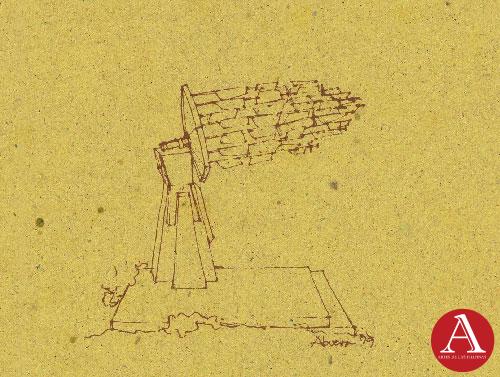
THE SPIRIT OF BUSINESS
When asked by a lady professor of the college as to the title of this free standing sculpture in iron and stainless steel, copper and brass on a reinforced concrete base, I told Prof. Melba Cantoria of the College of Business Administration and auditor of the Central Bank, that it is entitled “ The Spirit of Business .”
Actually to depict a sculpture or in contemporary form.” The Spirit of Business” is indeed a difficult task. For how on earth can one really depict the spirit of business?
I think on the layman it means the study and application of progressive management of wealth and resources.
Visually, in this sculpture, the symbols are in geometric entities and principally then cylinder which is the dominant form. Not only does it denote the round coin, but also the circular form has virtually no end and no beginning, just like the perennial of supply and demand, a perpetual motion which is a synonymous to mobility or being always on the go. Perhaps in higher vein just like the saying, money makes the world go round and round.
The main support of sculpture is a disk that can be rotated manually. From this disk, emanates all the projecting stainless steel rubber tubes with varied a multiple pierced components which are supposed the depict the complexity and indeterminate nature of the world of business.
The uneven movement and rotation of the blades symbolizes the ups and downs, the gains and losses inherent in business undertakings.
The sound of bells and other vibrations suggest the subdued back ground music in the bank or in aboard room or almost unbearable clutter of sounds in the Divisoria market.
And why are they all pointed skyward? Another faculty member of the college, prof. Johnny Uy, upon seeing the design several months ago, immediately described it as Star Wars. And why not?
Well, we often hear of business slogans like hitch your wagon to a star, sky is the limit, sky-rocketing prices, search for the moon, and to find one’s place in the sun and the meteoric rises in the business world. To some extent, I like to think that businessman or administrators are practical stargazers, unlike artists who simply orbit with the stars.
Before I chose, I would like to thank Dean Emmanuel Velasco whose concern for the arts which are representing are represented here in the other media, has provided the college with viable balance of business and art.
Also to our most charming and energetic fund raiser, Mrs. Fanny Cortes Garcia, who made the art commission in this building possible.

A GRAVE PROPOSAL
I am aware that there are many topics of great interest which will be presented and discussed this afternoon, so I have to be brief in presenting my topic or proposition. Especially so, of the fact that my topic is far from being interesting in the academic sense. Nevertheless, to some degree, I can assure you that my chosen topic is most restful and lasting.
Sooner or later, one by one and whether we like it or not, we will find ourselves “in the land of hereafter”, hence the imperative need of University Cemetery.
Three weeks ago, I found myself driving in my car with the bereaved family of one of our janitor whose son died. It was a long and hot drive to a place familiar to us – La Loma.
To my great surprise, Mang Ape our janitor, he spent no less than two hundred forty pesos for funeral expenses in the hiring the cheapest funeral parlor he could find. A substantial part of the amount went to the rent of the lot which was paid to the office of the cemetery, diggers and masons and the permit from the Quezon City Hall. So there you are even in death one is not spared by red tape. And you can imagine the time element wasted if our entire departed member would have to be buried in that far, congested and rather neglected place. Indeed, it is a far Cry from the serene beauty of the American Cemetery in Fort William McKinley where one cannot help but commune with nature. To me, it is one of the loveliest sites in our country.
Certainly, two hundred and forty pesos is too high for a janitor and even an instructor to pay and more to our misery the cost of the funeral services is getting higher and higher.
This very grave preposition is not my original idea. Credit should go to our good friend Prof. Johnny Uy for his novel idea. Having been inspired by the inherent beauty of such a lasting proposition and out of love in designing memorials, I was compelled to design and execute a model of a gate to our visionary University Cemetery. I sincerely believe the design is comparable to the design of our gateway to the University which I had a good fortune of designing and which became a structural reality through the generous technical assistance of the DCCD Engineering Corporation. Of course I do not mean to impose my design that is why I am keeping it, hoping that if, and when, this serious preposition is really taken seriously, I have already something to submit in a competition or to a committee.
Another good friend and also from College of Engineering, Prof. Bert Reyes made a remark which should be of interest to our respect and most able Business Executive, is is the simple fact that it could be a sure source of University income. According to Prof. Reyes, lots could be rented for a period of five years after which, the remains would be placed in a small boxes and buried in the ground. All of them with a simple and uniform marker irrespectively of faculty rank truly, the emergence of absolute academic equality.
Providentially, all the physical requirements of a University Cemetery is in our favor. The possible site which has been suggested and in which Dr. Jose Vera Santos , I am sure is agreeable is the land area between the Nuclear Reactor, and the U.P Arboretum.
I cannot help, but venture further to say, that if the road to our future resting place is coursed thru the cool, shaded road of the Arboretum, then to attend to a funeral procession will be most memorable and enjoyable. We would then be constantly reminded of the words of Robert Frost: “The woods are lonely, deep and dark, but I have promises to keep and miles to go before I sleep.”
The proximity of the place to the University proper would be convenient for us to visit the academic remains of our departed colleagues.
At the outset in the presentation of this proposition I made special mention of the various University Administration Officers, Deans, and Directors because of the age bracket and apparent support of statistics which show that they are the most logical and immediate beneficiaries of the project. I do not wish nor pray that it be so, no sir. Nevertheless, nature has bestowed upon them the priority in joining the inevitable”innumerate caravan”.
I hate and am sad to say that perhaps in our next faculty meeting one or more of us may be unable to be here simply because the fulfillment of natural or Divine regulation has to be met by one or some of us at a time most unexpected to most of us. I bet majority of us would be caught flat.
Don’t you want to lessen the burden or the living? I beg you king indulgence to spare some sober thoughts on this very grave proposition. --1965
A GRAVE SITUATION
(An open letter to the 14th President of the University of the Philippines.)
Mr. President, I am glad you are opening the floor to the other matters because I have one matter I mind which I think in more ways than one supersedes all whether official or personal.
But before I go into the heart of the matter, allow me to say a few words by way of introduction as pertinent matters or what you may call in law circumstantial evidence relevant to the case.
It is a fact that the faculty and non-teaching staff of the University offer or give the best years of their lives in the service of the University. It is also a known fact that the administration of the university is desirous of giving more benefits to both the faculty and non-faculty personnel in terms of remuneration and related benefits. However, much as the University Administration would like to do so, it cannot do so because of the fiscal or financial restrains. We are all aware of the limited sources available to the University.
Furthermore, Mr. President, it is a glaring fact that the cost of living is fast rising. But Mr. President, damn the escalating cost of living, the cost of dying far more expensive. I honestly believe an instructor or an assistant professor or an employee in the university cannot afford to die and be buried in comparative style without the untold financial burden on those left behind. I honestly believe further that is the duty of the living to lessen this burden both financially and emotionally.
There is an administrative necessity to have a cemetery, now better known as memorial park. The area which I then proposed, the arboretum, was threatened with squatters have invaded the site with impunity. Let us put to good use our academic dead. Let them guard a critical area in our university perimeter.
This substantial, lasting and encompassing fringe benefit is within the gasp and the giving of the Board of Regents. Why our mortal remains should be deprived of a decent and reasonable resting place.
The Jesuits and Dominicans are a lot more fortunate. The have their respective places in Novaliches and San Juan. Whereas the U.P. academic remains are squandered elsewhere.
The cost of a lot in Loyola, or in Manila Memorial or Eternal Park is already from Two Thousand Five Hundred to Three Thousand Five Hundred pesos. How about the casket, the permits, the black Cadillac that takes you academic remains to its final journey. This is not to mention the coffee, cookies or cakes that you would have to serve your friends while you lie in state. And mind you, while your friends sipping around your coffee or tea, the least they will think is to repose of your soul. Current events and renewal of acquaintances are most likely to occupy their minds.
In short, Mr. President, I merely want to reiterate a proposal I made during the administration of Pres. Romulo, where in the faculty conference open forum in Baguio, I spoke on a grave matter. Pres. Romulo was indeed pleased with my proposal but unfortunately if I may say so, an ex-president or member of the board of regents or any outstanding faculty member died soon enough to dramatize the situation.
As we are all aware, death is like a thief in the night. It strikes when least expected, so let us not be caught in a flat footed.
This reminds me, Mr. President of a Filipino captain whose boat was moored in Yokohama Bay sometimes in 1966. After vainly waiting for several days for his return to berth his ship, he finally decided to have a most rewarding evening. So one evening, he requested his first mate to look for a rosy chick.
While he was on the top and on his finest and most lingering moments, he had a massive cerebral attack. Oh, how profusely, innocently and openly did the Japanese girl weep. In bewilderment, she could not reconcile the fact that of a cause or cost, there she was offering or giving all she had and, yet the captain had to die.
Well, Mr. President, the morale of this incident in Yokohama Bay proves that whether you are on Mount Fuji, in Marikina Valley or in San Andreas Fault when death comes, it does come irrespectively of place and position.
In a lighter but a quite serious vein, Mr. President, allow me to say that with your systematic and procedural charisma, you only have to imply to the member of board of regents that they are the immediate beneficiaries of this project. Considering that most of them are advanced in years and are virtually dispensable. Not to mention the fact that some are really not so irreplaceable.
Let us consider the conveniences and benefits that would accrue, so that in some home comings in the distant future, when thoughtful alumni would wish to visit the academic remains of their favorite professors, all they have to do is walk less than a mile, and they will be their pondering over the dust that was once a source of enlightenment.
Furthermore, Mr. President, let us try some innovation in our University Memorial park. Taking into account that the physical area of the proposed site is fixed while the faculty and personnel are elastic. Let us advocate vertical burial and save space. Definitely, this is an improvement on the manner our forebears assumed. The burial jars restricted them to a squatting position. Ours will be standing with straps on the forehead, belly and knees.
The need to compose new songs to lighten a normally sad occasion is imperative. We trust, Mr. President, the College of Music will rise to meet the challenge.
The time, Mr. President, is rather late but not too late, for you and I and all the members of the academic community do still have a chance to die. So far, nobody has yet been exempted from joining the caravan of no return.”
I trust and pray, Mr. President that you will sleep with the grave matter. That in your sleep, the almighty will enlighten you, that in return, this grave matter will embolden you to crusade for the fulfillment of a University Memorial Park, knowing only too well that in the final analysis it will enrich the Diliman soil.
When the cherished project becomes a living reality, it will be said and will be written that the fourteenth President of U.P. was a man not only with a legal mind but also with a humanist perception.
For was it not Lord Chesterfield who said: “show me a civilization that cared for is dead, and will show you how great civilization is.” --1982
TIME FOR VERTICAL BURIAL
In life as in death, space or given area is indeed important, which maybe imperative or even expensive.
A given land area has fixed dimension no matter how big or small. Population, however, is ever-increasing every second of every minute.
A good way to conserve and more than double the capacity of our Memorial Park and cemeteries is to practice vertical burial in the lawn type lots though out the country.
It is not a entirely noble idea actually. But as our history attest, our forebears were buried in a squatting position inside burial jars or urns. To bury our dead in a standing position would more than double the internment capacity of the lawn type lots in our memorial parks.
It would also mean economy in the use of wood boards, since coffins would have to be designed slimmer to confine the body in a vertical position. The coffin will have a minimum of three (3) straps (made of cloth bands or even rope) to keep the body snugly upright. One on the forehead, another on the stomach or belly and third on the knee area. The common feature of having a viewing glass will be retained.
An optional feature of the coffin would be a concrete catch basin at the base to provide for a complete recovery of the bones. This will also help stabilize the coffin, if a vertical position is required or desired during the wake. Positioning the coffin upright would also solve the problem of space in a limited room for a wake.
In areas of the country where wood is comparatively scarce and expensive, like in the Ilocos Region, the burnay or the earthen jar may yet find a new role or usage or utilitarian value. However, the burnay jar height has to be increased and the opening widened to accommodate the body. The lid will have to be enlarged accordingly. Needless to say, we will be repeating or doing again the ancient way of burying the dead in a squatting position.
It will also necessitate the immediate placement of the body inside the burnay jar soon after death.
The disadvantage of vertical burial is that it would require a much deeper excavation. In adobe or stoney areas, it would require more effort in digging a hole approximately measuring 80 centimeters by on meter or say one meter square and at least three meters deep.
I am not sure if the leading memorial parks will welcome this proposal. On the premises that parks would increase their capacities, vertical burial would mean also a substantial lowering of the cost per lot. In the end this would generate more lot sales for memorial parks and cemeteries and accommodate more of our love ones.
So when you write your last will and testament, just write at the bottom of the document: “Verbu in slimcof”, which means, I desire a vertical burial in a slim coffin.
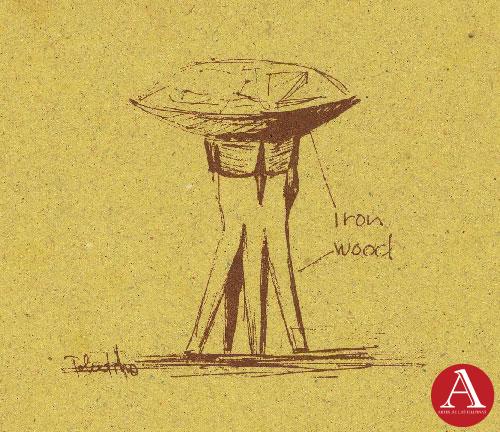
NOTES IN GUILLERMO E. TOLENTINO
It is beyond doubt that Professor Tolentino is the first and last master in representation of the human form in the Philippines.
I remember so well the years 1950-53, when I had a good fortune of being asked to assist my Maestro in some of his works. His concept and attitude towards the depiction of the human form is akin to that of the Geek sculptors during the year of Phidias or the glory that was Greece.” Not only the idealization of man but also his nobility is given emphasis. There always the stance of the heroic and monumental epic in his portrayal aside from being a faithful interpretation of the subject.
Several times, I heard him say that the bust or statue should resemble the subject or model. If the spectator does not recognize the subject, it is rather masakit sa dibdib, soul wrenching on the part of the sculptor or artist.
Once I entered his studious at No. 5 Retiro Street and found him modeling a small head. Innocently, I asked who the model was. My good Maestro said, “You know who she is; she is a doctor from UP Infirmary.” Only then I realize his admonition about the basic requirements of a bust or portrait sculpture.
Of the many isms or aspects with which modern art has become, synonymous, it is the word distortion which the Maestro vehemently abhors. I think it is not only” cardinal or pontifical” sin to my maestro; it simply cannot exist for him and is unthinkable.
Perhaps next and in some degree equal to his chosen mission is the attention he gives to the spiritual movement of the Philippines of which he is among the founding fathers. Sometimes, I hink the spirit is one way or another assist him morally and spiritually in his works. But there is one thing I always like to think and believe. Considering that Prof. Tolentino is so fortunate to have a partner in life who is understanding and, a beauty in her own right at that, I a cannot help but to suspect that may good Maestro must have consulted the spirit before making the supreme decisionin “ taking” his woman. One has to admit that Guillermo E. Tolentino in his forties was a dashing man, as portrayed in an old photograph. But I would dare insist that even the kind spirit did not have a full idea of how Paz Raymundo would be to be the muse and sources of inspiration and love of the sculptor. --1968
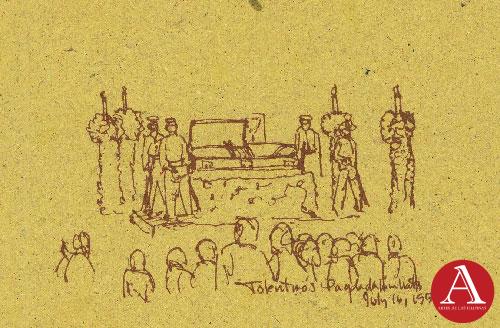
HOMAGE TO GUILLERMO E. TOLENTINO
Throughout out the long and fruitful years of his life, Maestro Guillermo Tolentino allowed us to share and made us aware of the beauty and meaning of the images he modeled and carved with his mind hands and heart.
He portrayed so well the proud heritage and destiny of his people through his heroic and a monumental master work – the Bonifacio monument which actually is a profound visual history of the greatness and genius of the Filipino people. Thus enriching our perception and making us heirs to the retirement of his art and allowing us to partake of what he considers the prerequisite of all great works of art.: no other than the true, the good the beautiful.
As mentor, he was so understanding and kind. His respected and admired him like their own father.
As one of the founding fathers of the Union of Spiritists, he gave so much of his time and extended considerable materials assistance to a good number of its member.
Now, he is free from the strenuous labor of the art of sculpture. Free from the toughness and unyielding nature of marble, stone, metal, wood and other sculptural materials. Free from the flying marble chips which always lodge in the carver’s eyes, the marble dust which in no time cakes around one’s eyes nostrils, the constant tempering of points, the strength to pound the hammer continuously and free from the demands of the trade.
Yes, what a release it is to pass. Yes, it really is, when one has done his best.
In behalf of those whom he loved and those who loved him so much, Mrs. Paz Raymundo Tolentino, sons and daughters, Liwanag, Lualhati, Dalisay, Soliman, Magligtas, Isagani, Marikit, their wives and husbands and other relatives, we are deeply grateful for sharing with us our thoughts and feelings. --1976
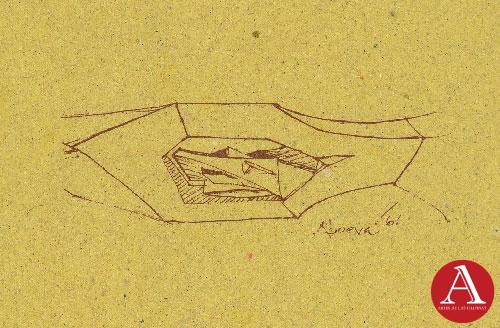
MANG ENTENG
Much has been written and said about the man and the artist whom we are honoring this morning. I must say that there are other individuals present who are in a better position to say a few words.
In the authorative book on Manansala by Dr. Rodolfo Paraz Perez, what have to be presented from the aesthetic point of view was thoroughly dissected and evaluated; hardly anything escaped the author’s pen.
However, the varied, active and colorful life of Mang Enteng present a lust which I believe can sharpen and refresh our sensibilities and thought about the man, the artist our very own Mang Enteng.
Last year when Mang Enteng restored the heavily damaged portion of the station of the cross at the U.P. Chapel of Holy Sacrifice, for love he complained to Mrs. Odette Alcantara that Father Manny Gabriel did not even serve him coffee. Whereas when he restored the National Press Club mural, Mr. Doroy Valencia always fed him. Hoping something could be done to assist Mr. Manasala in his predicament, Odette informed her sister in U.P., Mrs. Nieves Epistola. But Mrs. Epistola that, that was good for him, for he had not known hunger for a good number of years. She reminded him of his lean years, when a slice of cheese or a bunch of grape could only be had during Christmas and special Occasion, knowingly fully well that in his present station everything was at hand. All this unexpected reminder from a lady, Mang Enteng took nicely, like a saying that “the things that are hardest to bear are the sweetest to remember.”
In last year’s Mobil Art Awards, competitive Mang Enteng was always the first to arrive. It took so much of his time in the long deliberation which lasted for hours. In the Final evaluation of the Finalist, although his choice was not selected by the majority, he took it in a most congenial manner but only after thoroughly presenting his side.
As a measure to Mang Enteng’s love and thoughtfulness for his wife, every wedding anniversary and birthday called for a special artwork or a present from him. I am sure most of my artist friends would not like their wives to know this because it is indeed a self-imposed obligation impossible to fulfill by ordinary mortals such as me.
To all the people who provided him the encouragement, lent him assistance during his formative years, gave him comfort and confidence in facing the complex problems and vicissitudes of life, we, the artists, are indeed very grateful.
In the words of W.C. Smith, “The world is full of beauty when the heart is full of love.” Judging from his manly and natural disposition. I think it is safe to say that Mang Enteng’s heart was so filled with love, hence beautifully permeated practically everything that he did.
“Our mind’s well, eased from weariness of toil, from the thought that our goal is our people’s happiness,” remember those words because they are not mine. They were written by the late President Manuel Roxas. The joy and contentment derived when confronted by a Manansala painting, is the legacy bequeathed to our people.
To his beloved wife, Aling Hilda, the constant and most understanding companion in a fruitful life, for which a number of significant paintings in the collection of the National Artist, bore the inscription” to my wife Hilda” with love; to his only son Maning, who is not an artist in the common sense of the word but has found beauty in the precise dynamics of machines and the tools of technology, we share their deepest sorrow yet we too share their profound joy in the knowledge of the passing of a great artist and man.
It has been said that “What we keep in our heart is ours: it will never die.” -- 1981
LORD PLEASE HELP ME COMPOSE A SONG
Lord please helps me compose a song
I can sing to you on Christmas day.
You once said, you’re going to help those
who help themselves
Yes, my Lord, I’m trying my best but my best
but my best is not good enough.
So, Lord, please help me compose a song
I can sing to you on Christmas day.
If I may say, I’m going to tell my friends
You helped me composed this song
If I may say, this is the best birthday
gift I can give to you on Christmas Day.
Many, many thanks, my Lord,
For helping me compose this song
Many, many thanks, my Lord,
For giving me the nerve to sing this song
on Christmas Day.
HALO, HALO OY HALO
Sila ay laging magkasama
Sila ay mahalaga
Sila ay naroroon sa lahat ng fundasyon
simyento, buhangin, graba, tubig, at ang kabilya
ay naghihintay sa loob ng porma
Pare, matigas ihalo ito, bubuhusan ko pa ng tubig
Hoy ulol, paano yan makakaabot ng 3000 PSI
Labis na labis ang sabaw, ay malabnaw
Sila ay laging magkasama
Sila ay mahalaga
Sila ay naroroon sa mga bahay na matitibay
Pare, anong 3000 pichay ang sinasabi ng engineer?
Hindi Pare, 3000 PSI- pounds per square inch
Ang kayang dalhin pag tigas ng halo
Pare, that’s beyond me?
Sila ay laging magkasama
Sila ay mahalaga
Sila ay naroroon sa mga highway
na matitibay
Oy, bumukol itong pormal
Na putrages tayo!
Sinong carpenterong assign dito
Parang pitsugin 'yong iyong trabaho
Monolithic pouring yata ito
Sila ay laging magkasama
Sila ay mahalaga
Sila ay naroroon sa mga tulay na matitibay
Pare, galit yata yong engineer
Lintik raw yon gating buhos
Hindi Pare, monolithic
Ibig sabihin isang buhusa n lang, at walang
dugtungan, kasi ang biga at poste ay kritikal
member ng estrakture.
Pare, that’s O.K. with me.
Halo, oy halo
Ang bagal mo naman
Hindi ba kayo nag almusal?
Maski okoy
Oy halo, halo
Sila ay laging magkasama
Sila ay mahalaga
Sila ay naroroon sa mga nicho sa sementeryo
Pare, pwedeng pwede ka na ngayon
Ang bilis mong maghalo
Pare, kung one bagger lng, wlang
laban sa akin
Pare, believe na believe ako sa iyo
Halo, Halo oy halo.
Sila ay laging magkasama
Sila ay mahalaga
Sila ay naroroon sa lahat ng fundasyon.
BAKIT KA NAGPAKAHIRAP
Lumipas ang mahabang panahon
Ang mundo ay hindi nabago
Kumakalat na nag digmaan
Ang buhay at hindi na mahalaga
Bakit ka nagpakahirap
Bakit ka umasa
Hindi ko naman masabi na saying lang
Ngunit malaking bagay sa akin na masabi ko
Sa loob ng dalawang siglo
ang tiwala ay lumalabo nabubura ang mga himala
Dapat panibagong himala panibagong pag asa
panibagong tiwala
Bakit ka nagpakahirap
Bakit ka nagpakahirap
WHAT IS LOVE?
It is not back
to back;
So strong, it can
split the
Hardest stone.
It is heaven
on earth
In a consummate
embrace;
Or hell: -- Your feet
on a twin
Barbeque pit;
stretchable,
Yet breakable like a sail:
subject to the
Winds of feeling
ANO ANG PAG IBIG?
Hindi ito likod
Sa likod;
Napakalakas upang maka-
biyak ng
Pinakamatigas na bato.
Ito ay langit
sa lupa
Sa isang ganap
na yakap:
O impiyerno: amh mga paa mo
magkakambal
Sa isang ihawan;
nababanat
Ngunit masirain tulad ng isang layag:
nasasaklawan ng mga
Hangin ng damdamin.
Translation by Larry Francia
MINI-SKIRTS
“It’s now beyond doubt that the limbs of Filipino women are more shapely and inviting than previously thought. Thanks to the coming of the mini-skirts. In fact the very soul of the matter is, it has brought our vision closer to the junction of happiness.
THE NUDE
“My subject matter is basically humanistic. Only the dead are at peace with the nude.”
The better half (singular or plural)
(in the war) I like to think my wife is the only certified Vietcong in the Philippines. You get ambushed without provocation. You have to declassify your pockets before reaching your “hamlet.”
If a super power failed to contain them, what chance do I have with a single armament?
(in peace) It is like reaching “The unreachable stars”, O.K. na O.K. talaga!
But peace is always illusive. It does not have the daily frontality of war. It reminds me of Virgil “show me a place on earth where there are no calamities."
(consolation) I guess a good number of Filipinos ends up marrying woman immersed in un-Filipino instincts or activities.
Maybe the changing realities, situation and other factors beyond the control of both parties are to be blamed.
Amazingly, we manage to keep our sanity.
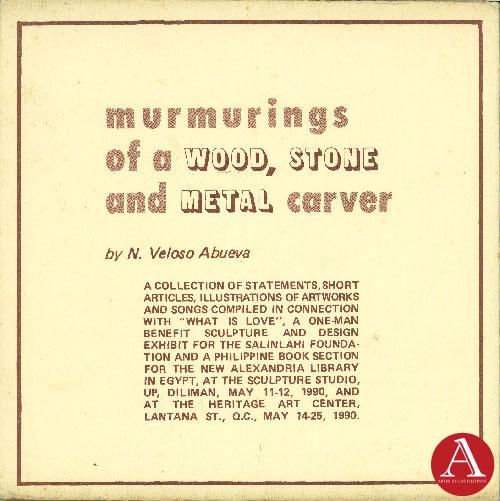
Recent Articles
 FEDERICO SIEVERT'S PORTRAITS OF HUMANISM
FEDERICO SIEVERT'S PORTRAITS OF HUMANISMJUNE 2024 – Federico Sievert was known for his art steeped in social commentary. This concern runs through a body of work that depicts with dignity the burdens of society to...
.png) FILIPINO ART COLLECTOR: ALEXANDER S. NARCISO
FILIPINO ART COLLECTOR: ALEXANDER S. NARCISOMarch 2024 - Alexander Narciso is a Philosophy graduate from the Ateneo de Manila University, a master’s degree holder in Industry Economics from the Center for Research and...
 An Exhibition of the Design Legacy of Salvacion Lim Higgins
An Exhibition of the Design Legacy of Salvacion Lim HigginsSeptember 2022 – The fashion exhibition of Salvacion Lim Higgins hogged the headline once again when a part of her body of work was presented to the general public. The display...
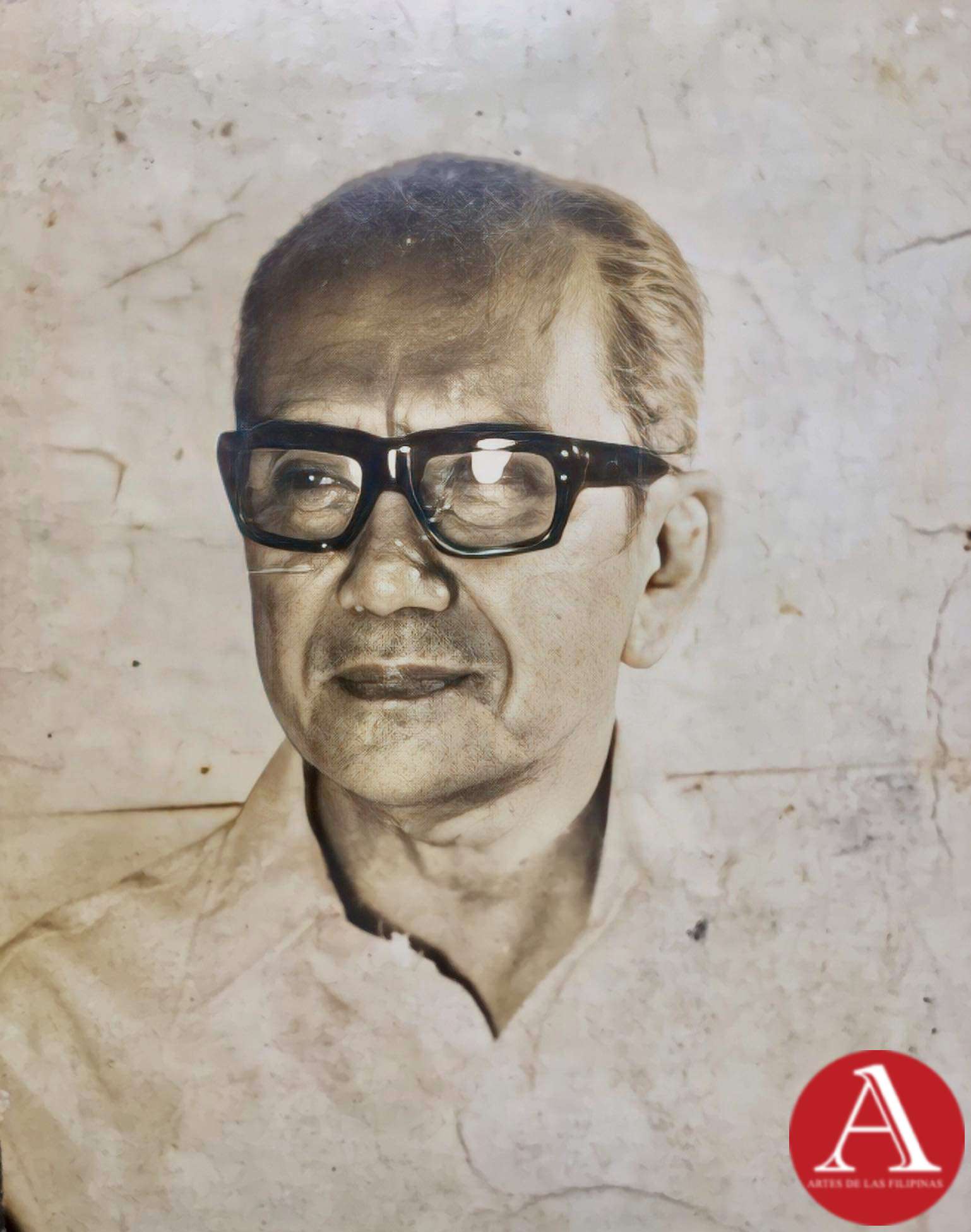 Jose Zabala Santos A Komiks Writer and Illustrator of All Time
Jose Zabala Santos A Komiks Writer and Illustrator of All TimeOne of the emblematic komiks writers in the Philippines, Jose Zabala Santos contributed to the success of the Golden Age of Philippine Komiks alongside his friends...
 Patis Tesoro's Busisi Textile Exhibition
Patis Tesoro's Busisi Textile Exhibition
The Philippine Art Book (First of Two Volumes) - Book Release April 2022 -- Artes de las Filipinas welcomed the year 2022 with its latest publication, The Philippine Art Book, a two-volume sourcebook of Filipino artists. The...
 Lamberto R. Hechanova: Lost and Found
Lamberto R. Hechanova: Lost and FoundJune 2018-- A flurry of renewed interest was directed towards the works of Lamberto Hechanova who was reputed as an incubator of modernist painting and sculpture in the 1960s. His...
 European Artists at the Pere Lachaise Cemetery
European Artists at the Pere Lachaise CemeteryApril-May 2018--The Pere Lachaise Cemetery in the 20th arrondissement in Paris, France was opened on May 21, 1804 and was named after Père François de la Chaise (1624...
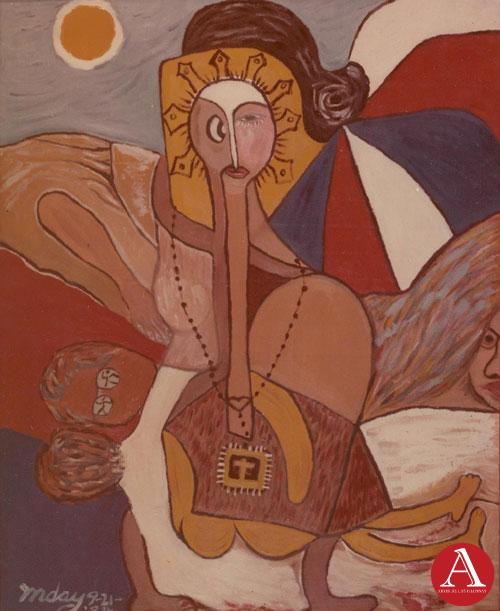 Inday Cadapan: The Modern Inday
Inday Cadapan: The Modern IndayOctober-November-December 2017--In 1979, Inday Cadapan was forty years old when she set out to find a visual structure that would allow her to voice out her opinion against poverty...
 Dex Fernandez As He Likes It
Dex Fernandez As He Likes ItAugust-September 2017 -- Dex Fernandez began his art career in 2007, painting a repertoire of phantasmagoric images inhabited by angry mountains, robots with a diminutive sidekick,...




